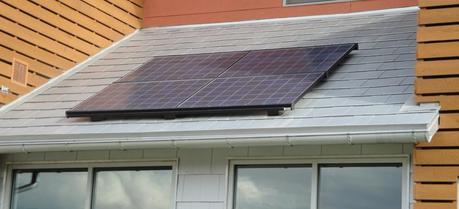 A new UA study to determine what motivates people to install solar panels at home. (Credit: Dave Dugdale / SolarDave.com)
A new UA study to determine what motivates people to install solar panels at home. (Credit: Dave Dugdale / SolarDave.com)Homeowners install solar panels for a variety of reasons, but one UA study is gaining insight into what truly motivates them to go green.
A University of Arizona professor is collaborating with the National Renewable Energy Laboratory on a study of why individual households choose to install their own rooftop solar panels.
According to the news release, the study’s goal is to gain an insight into how solar users think—whether solar users act out of purely environmental motives, long-term economic considerations or a mixture of different factors when deciding to install solar panels.
Adam Douglas Henry, assistant professor in the School of Government and Public Policy, is part of a multi-institute effort to determine strategies that can help promote a more widespread use of solar technology. Funded by the Department of Energy (DOE), the collaborative project aims to find the most cost-effective ways to encourage households to go green.
“The idea behind this is to look for actionable lessons that we can use to increase the rate at which residential households are adopting solar energy,” Henry said.
Under the DOE’s SunShot Initiative—which began in 2011 with the goal of making solar energy cost-competitive with other forms of electricity by the end of the decade—Henry received a $517,000, three-year grant for his role in the study.
“At the University of Arizona, we are building computer models of how households are making decisions about installing or not installing rooftop solar,” Henry said. “In the past, the diffusion models that are used have been relatively simple. They don’t take into account the psychology of these decisions and the roles of social influences, social networks and interactions with one’s neighbors in making these decisions, but research suggests these are powerful forces behind adoption of new technologies.”
The project will involve a large-scale household survey, using Arizona, California, New York and New Jersey as test locations. The selection of these regions was deliberate to get data on variations in climate as well as historical policy support for solar energy.
“Arizona and California are somewhat comparable in terms of solar resources,” Henry said. “California and New Jersey have interesting similarities because both states have seen higher rates of solar adoption because of state incentive programs.”
The SunShot program aims to make solar energy competitive with other forms of energy without relying on government subsidies.
“Understanding how to do this depends on understanding why people make their decisions and to what degree different external factors influence those decisions,” Henry said.
“The economic calculation is one piece of it. Just looking at how much it costs and what benefits you’ll get out of it is clearly an important part of how you’ll increase solar adoption,” he said. “But understanding how to increase adoption without all these tax incentives means we have to understand the non-economic factors that influence household solar adoption.”
Currently, Henry is developing theoretical models and working on calibration and testing, using a sample of data from Southern California.
“We’re selecting these regions in part because we have a good bit of data on household-level decisions about whether they adopt. In terms of understanding the forces behind adoption, it is best not to think of this as a comparison of four states, but as a comparison of thousands and thousands of American households,” Henry said.

